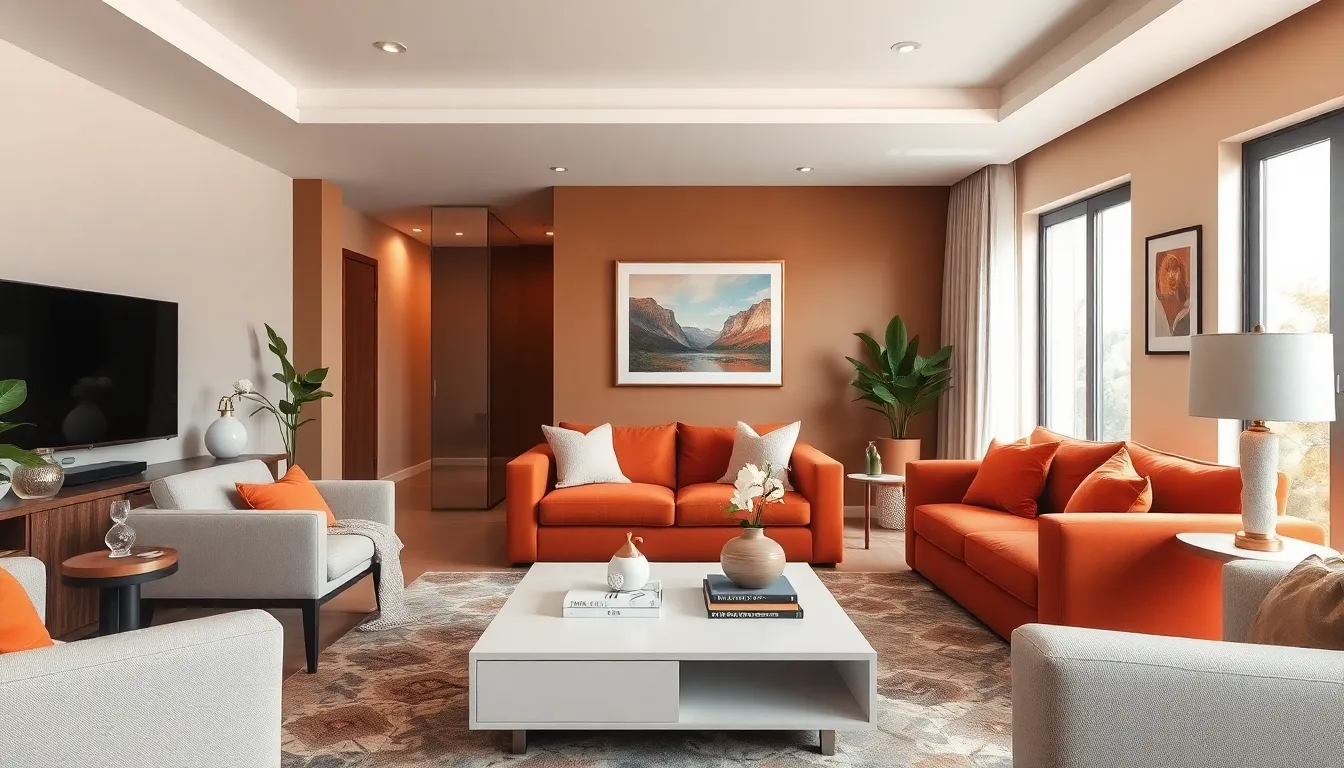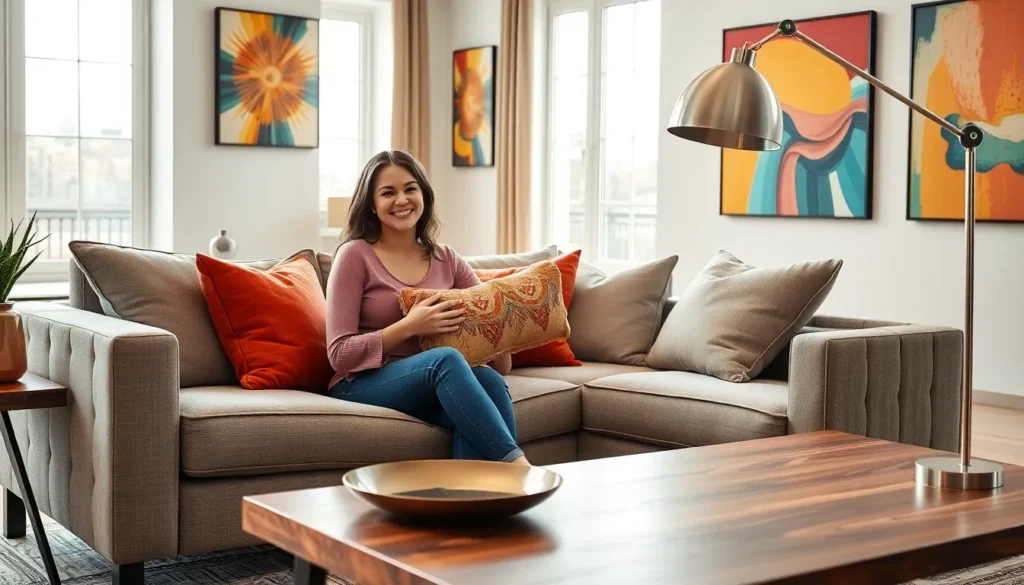Decor design isn’t just about throwing a few pillows on a couch and calling it a day. It’s an art form that transforms spaces into reflections of personality and style. Whether it’s a cozy nook or a sprawling living room, the right decor can make a world of difference. Who wouldn’t want their home to feel like a Pinterest board come to life?
Table of Contents
ToggleOverview of Decor Design
Decor design represents an essential component of interior spaces, contributing to aesthetics and functionality. Each element within decor design plays a role in creating a cohesive environment. Color schemes evoke emotions, while textures add depth and interest. Furniture selection impacts both flow and usability, ensuring a balance between style and comfort.
Materials hold significant importance in decor design. Natural textures, like wood and stone, provide warmth, while metals introduce a modern edge. Fabrics contribute to the sensory experience, influencing how spaces feel and look. Layering various materials enhances visual appeal and promotes a curated atmosphere.
Art pieces and accessories personalize spaces, reflecting the inhabitants’ tastes and lifestyles. Wall art, sculptures, and plants facilitate lively interactions within the space. Additionally, lighting design is crucial; it establishes mood and highlights focal points. The right combination of ambient, task, and accent lighting can transform a room from ordinary to extraordinary.
Applying principles of decor design influences both residential and commercial settings. In homes, decor helps define personal style and create inviting sanctuaries. Offices utilize decor to foster productivity and engagement, showcasing brand identity.
Trends within decor design continually evolve, demonstrating the dynamic nature of this art form. Minimalism emphasizes simplicity, while maximalism embraces bold expressions. Sustainability influences choices, promoting eco-friendly materials and practices. Keeping up with emerging trends allows individuals to refresh their spaces while ensuring enduring appeal.
Overall, decor design involves thoughtful selection and arrangement of elements to enhance the experience of any space. It connects style with purpose, transforming interiors into aesthetically pleasing environments.
Key Elements of Decor Design

Decor design involves various elements that collectively enhance the visual and functional appeal of a space.
Color Schemes
Color schemes establish the mood within an interior. Warm colors like reds and yellows invite energy and vibrancy. In contrast, cool colors such as blues and greens offer calmness and tranquility. Combining complementary shades creates visual interest and can guide spatial perception. For instance, a neutral palette accented with bold hues allows for versatility while maintaining harmony. Selecting the right colors impacts emotional response and enhances the overall aesthetic, making careful consideration essential.
Furniture Selection
Furniture selection plays a crucial role in decor design. The right pieces balance comfort and aesthetics. Prioritizing functionality guides the decision-making process, ensuring that each item serves a purpose. For example, multi-functional furniture, such as a coffee table with storage, maximizes usability, especially in smaller spaces. Scale matters; oversized pieces can overwhelm while smaller items may seem lost in larger rooms. Creating flow with furniture arrangement promotes movement and fosters a welcoming atmosphere that complements the overall design.
Trends in Decor Design
Decor design continually evolves, reflecting changing tastes and societal values. Current trends highlight both aesthetic appeal and practical functionality.
Minimalist Design
Minimalist design emphasizes simplicity and clean lines. Neutral color palettes dominate, promoting a sense of calm. Furnishings tend to focus on essential pieces that maximize space without cluttering. Open floor plans enhance the airy feel, allowing for easy movement. Natural light plays a vital role, with large windows and fewer barriers creating a seamless connection with the outdoors. A select few decorative elements provide visual interest, ensuring spaces remain sophisticated yet understated.
Eco-Friendly Decor
Eco-friendly decor prioritizes sustainability through materials and practices. Natural materials like bamboo, reclaimed wood, and organic fabrics define this trend. Energy-efficient lighting enhances ambiance while reducing energy consumption. Upcycling furniture not only saves resources but also adds unique character to spaces. Plants and greenery also play an essential role, improving air quality and bringing nature indoors. Choosing local artisans supports community economies while emphasizing environmentally conscious consumption. Overall, eco-friendly decor combines aesthetics with a positive impact on the planet.
Tips for Effective Decor Design
Effective decor design hinges on thoughtful strategies that enhance spaces. Implementing key principles allows for a unified and inviting atmosphere.
Space Planning
Space planning requires understanding the layout and flow of a room. Identifying focal points helps in arranging furniture effectively. Considerations for pathways and movement within the space make for a seamless experience. Using zones within a room can maximize functionality, especially in open areas. Placing essential furniture first establishes a base, providing a framework for accessorizing the room afterward. Evaluating the size of furniture in relation to the space ensures that nothing feels cramped or overwhelming. Ultimately, a well-planned space boosts comfort and usability while maintaining aesthetic appeal.
Personalization Techniques
Personalization techniques play a vital role in making decor unique. Selecting artwork that resonates with individual tastes adds character to any space. Incorporating personal collections showcases interests and memories. Choosing accessories that reflect personal style brings warmth to interiors. Textiles, such as throw pillows and blankets, can introduce color and texture, enhancing visual interest. Utilizing family heirlooms or travel souvenirs adds layers of meaning to the decor. Simple adjustments, like swapping out seasonal decor, keep spaces feeling fresh and aligned with personal expressions.
Decor design is an essential aspect of creating spaces that are not only visually appealing but also functional. By thoughtfully selecting colors, textures, and furniture, individuals can craft environments that resonate with their personal style and enhance their daily lives.
Embracing current trends like minimalism and sustainability allows for a modern approach to decor that prioritizes both aesthetics and environmental responsibility.
Ultimately, effective decor design should reflect individual tastes while promoting comfort and usability. With the right elements in place, any space can transform into a welcoming haven that inspires and uplifts.



